You may notice USB devices may stop functioning correctly when multiple devices connected to the same USB hub go into selective suspend. In this post, we will identify the root cause of the issue, as well as provide the most suitable solutions to resolve the issue on your Windows 11 or Windows 10 computer.
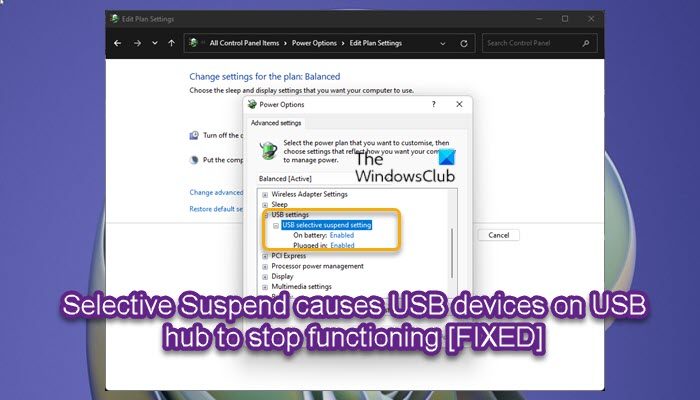
When this issue occurs, you’ll notice USB devices attached to the same hub are very slow or completely unresponsive. This issue occurs when one of the devices on the hub receives a wake request while the other devices that are attached to the same hub are going into selective suspend. If this happens before the suspend request has completed, the devices become unstable.
Selective Suspend causes USB devices on USB hub to stop functioning
The USB Selective Suspend feature allows the hub driver to suspend an individual port without affecting the operation of the other ports on the hub. Selective suspension of USB devices is especially useful in portable computers, since it helps conserve battery power.
If you’re faced with the issue, you can try our recommended solutions below in no particular order and see if that helps to resolve the issue on your Windows 11/10 system.
- Restart PC
- Disable and enable the USB Root Hub
- Disable Power Management for USB Root Hub
- Disable USB Selective Suspend feature
Let’s take a look at the description of the process involved concerning each of the listed solutions.
1] Restart PC
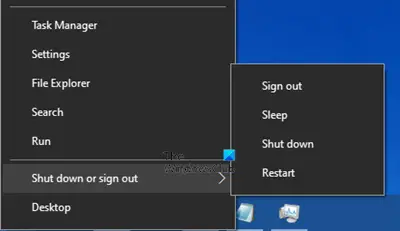
You can begin troubleshooting to resolve the issue on your Windows 11/10 PC by restarting your system. If restarting the computer fixes the problem, then good; otherwise you can try the next solution.
2] Disable and enable the USB Root Hub
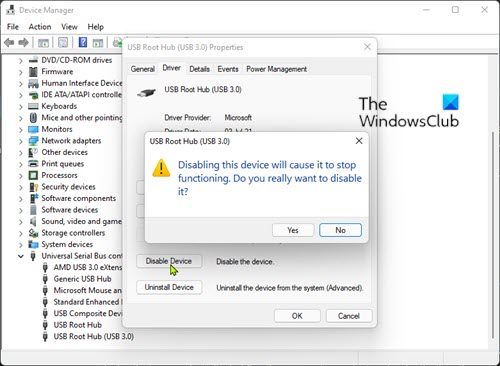
This solution requires you to use Device Manager to disable and re-enable the USB Root Hub. This action lets the controllers recover the USB port from its unresponsive condition.
To disable and re-enable the USB Root Hub on your Windows 11/10 PC, do the following:
- Press Windows key + X to open Power User Menu.
- Tap M key on the keyboard to open Device Manager.
- Once you’re inside Device Manager, scroll down through the list of installed devices and expand the Universal Serial Bus controllers section.
- Now, scroll to find and then double-click the affected USB Root Hub.
- On the Properties sheet, click the Driver tab.
- Click Disable Device.
- Click Yes on the prompt to disable device.
- Once disabled, restart the computer.
On boot, Windows will automatically scan for hardware changes and reinstall all the USB Root Hub that you uninstalled. After the computer restarts, check whether the problem is resolved. If not, try the next solution.
3] Disable Power Management for USB Root Hub
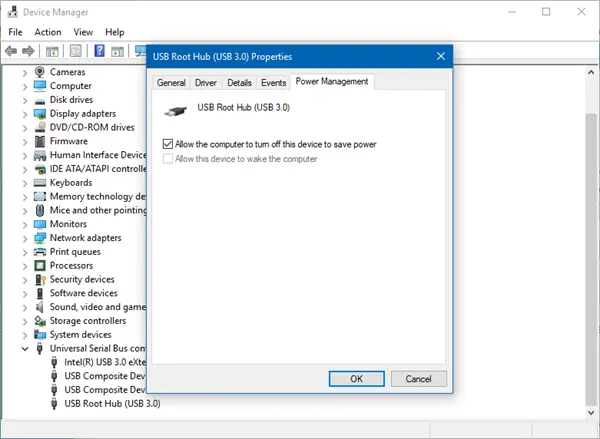
To disable Power Management for USB Root Hub on your Windows 11/10 PC, do the following:
- Press Windows key + X to open Power User Menu.
- Tap M key on the keyboard to open Device Manager.
- Once you’re inside Device Manager, scroll down through the list of installed devices and expand the Universal Serial Bus controllers section.
- Next, double-click USB Root Hub to edit its properties.
- In the Properties sheet, click Power Management tab.
- Now, uncheck Allow the computer to turn off this device to save power option.
- Click OK to save changes.
- Repeat if there are multiple USB Root Hub entry.
- Exit Device Manager when done.
- Restart PC.
4] Disable USB Selective Suspend feature
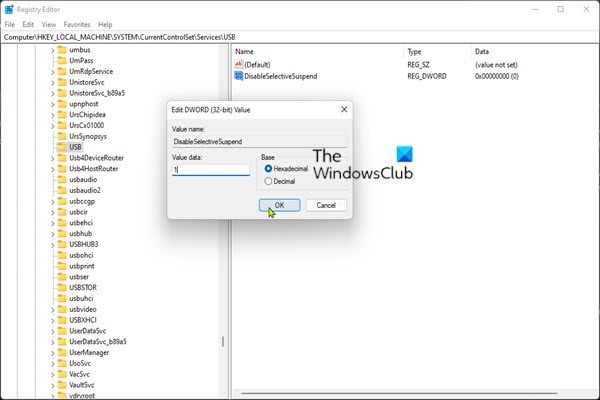
This solution requires you to disable the Selective Suspend feature. Keep in mind that when the Selective Suspend feature is disabled on your Windows 11/10 device, all USB host controller drivers, USB ports and connected USB devices in the system will be affected. The implication being, your PC will be unable to suspend any connected USB devices, and the USB devices can continue to use power while connected to the USB port on the computer. In addition, the Allow the computer to turn off this device to save power option will not appear on the Power Management tab for the USB Root Hub.
To disable the Selective Suspend feature via the Registry Editor, do the following:
Since this is a registry operation, it is recommended that you back up the registry or create a system restore point as necessary precautionary measures. Once done, you can proceed as follows:
- Press Windows key + R to invoke the Run dialog.
- In the Run dialog box, type regedit and hit Enter to open Registry Editor.
- Navigate or jump to the registry key path below:
HKEY_LOCAL_MACHINE\SYSTEM\CurrentControlSet\Services\USB
If the USB key is not present, you can right-click on the Services sub-parent folder on the left navigation pane, click New > Key to create the registry key and then rename the key as USB and hit Enter.
- At the location, on the right pane, double-click the DisableSelectiveSuspend entry to edit its properties.
If the key is not present, right-click on the blank space on the right pane and then select New > DWORD (32-bit) Value to create the registry key and then rename the key as DisableSelectiveSuspend and hit Enter.
- Now, double-click on the new entry to edit its properties.
- Input 1 in the Value data field.
- Click OK or hit Enter to save the change.
- Exit Registry Editor.
- Restart your PC.
Alternatively, you can disable the USB Selective Suspend setting via Power Options.
Should I enable USB Selective Suspend?
Depending on how you intend to use your PC, you may enable (default setting) or disable USB Selective Suspend. The USB selective suspend is a pretty nifty feature for laptop and tablet users, in that it saves power from unnecessary USB devices. So if you have not experienced any problems with your external USB devices on your Windows 11/10 laptop or tablet, you don’t really need to disable the feature.
Why do USB hubs stop working?
USB hubs can stop working due to static electricity which causes ports in the hub to stop working. A quick fix to this issue is to disconnect the power plug and the plug connecting the hub to the USB port on your computer, wait a few seconds and then reconnect the USB hub back to the system.
Why does a USB hub need to be powered?
There are 3 common hub types viz; Root hub, Powered hub and Self-powered hub. A powered hub uses mains power, it can supply every device connected to it the maximum voltage that USB allows. So, not only can it run more devices than an unpowered hub, it can do so at full power, without any performance hits.
That’s it!
Leave a Reply